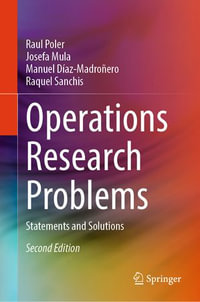
At a Glance
eText
$84.99
or
Instant online reading in your Booktopia eTextbook Library *
Read online on
Desktop
Tablet
Mobile
Not downloadable to your eReader or an app
Why choose an eTextbook?
Instant Access *
Purchase and read your book immediately
Read Aloud
Listen and follow along as Bookshelf reads to you
Study Tools
Built-in study tools like highlights and more
* eTextbooks are not downloadable to your eReader or an app and can be accessed via web browsers only. You must be connected to the internet and have no technical issues with your device or browser that could prevent the eTextbook from operating.
ISBN: 9780387712154
ISBN-10: 0387712151
Published: 5th May 2007
Format: PDF
Language: English
Publisher: Springer Nature
You Can Find This eBook In
This product is categorised by
- Non-FictionBusiness & ManagementOperational Research
- Non-FictionBusiness & ManagementManagement & Management TechniquesManagement of Specific AreasProduction of Quality Control Management
- Non-FictionComputing & I.T.Computer Science
- Non-FictionMathematicsOptimisationLinear Programming
- Non-FictionMathematicsCalculus & Mathematical Analysis
- Non-FictionEngineering & TechnologyMechanical Engineering & MaterialsProduction & Industrial Engineering
- Non-FictionComputing & I.T.Digital Lifestyle & Online World: Consumer & User GuidesInternet Guides & Online Services
- Non-FictionMathematicsApplied Mathematics
- Non-FictionComputing & I.T.Computer HardwareNetwork Hardware
- Non-FictionComputing & I.T.Business Applications
- Non-FictionComputing & I.T.Computer Networking & Communications
- Non-FictionBusiness & ManagementManagement & Management Techniques
- Non-FictionMathematicsOptimisation























